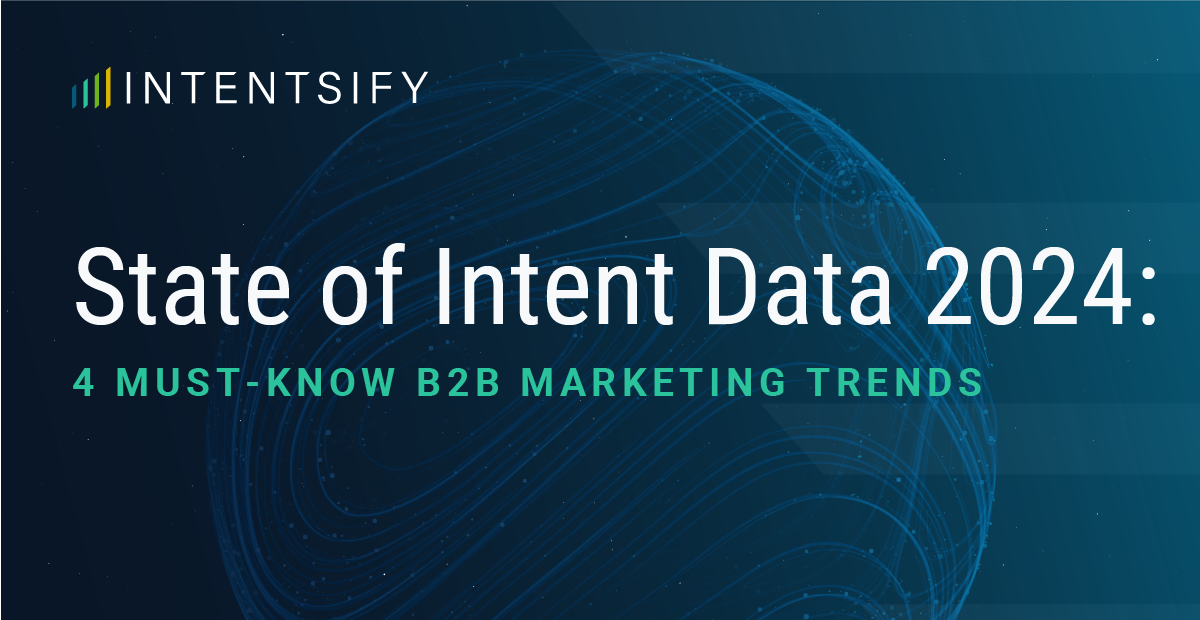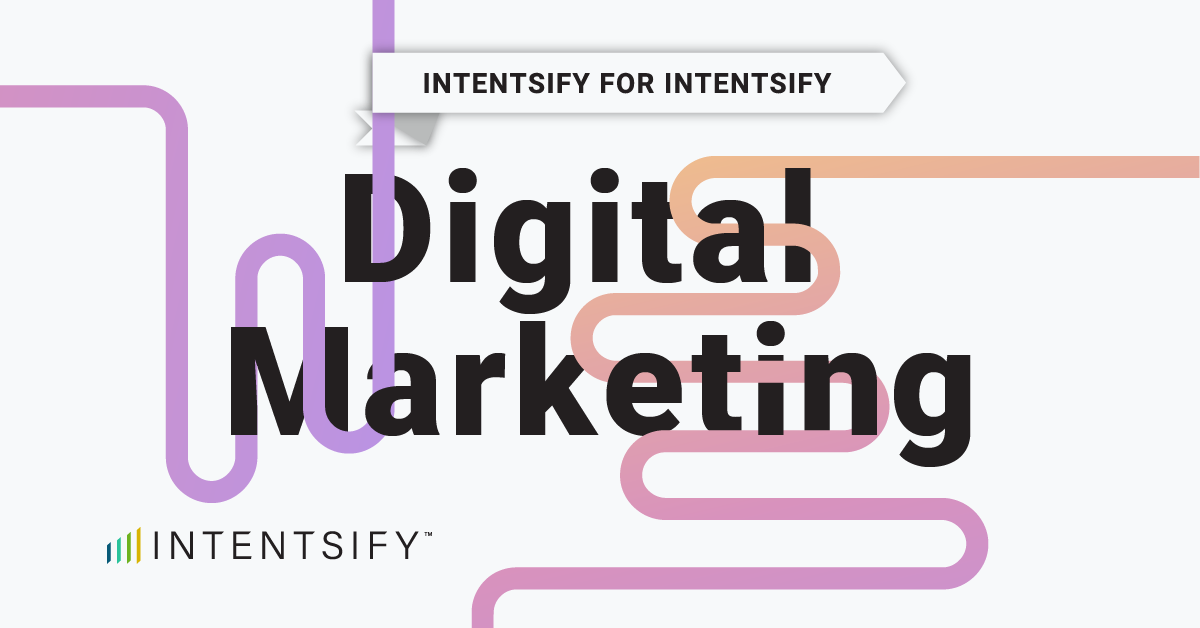A version of this article was originally published on CMSWire.
Content syndication and other forms of third-party demand generation are having a big year. To be fair, spend on all B2B digital channels is significantly up. eMarketer estimates that B2B digital spending will hit $8.14 billion this year, up 22.6% from 2019.[1]
Yet, content syndication is having a particularly good year. I’ve seen this internally at Intentsify; our intent-activated demand generation program has generated 5x more revenue this year than last year.
And as much as I’d like to think the jump is due to my incredible marketing abilities, it’s not.
The truth is several factors are responsible for the recent resurgence of content syndication.
Why Content Syndication Is on The Rise, Again
Covid-19
First, the obvious. A global pandemic shuttered in-person events, where B2B organizations typically allocate around 20% of their marketing budgets to fuel their sales pipeline. Digital events, while helpful in the absence of the real thing, simply can’t fill the void.
So, B2B marketing teams have been reallocating event budgets in part to content syndication programs to help make up for the loss. (Some anecdotal evidence: Intentsify’s intent-activated demand generation solution saw 2x jump in revenue between February and March of this year. And it had nearly tripled by the end of July.)
Inbound marketing isn’t enough
Traditional inbound marketing results can’t scale to meet businesses’ needs. I’ve written on this topic before, so I won’t belabor the point here. Suffice to say, however, the combination of account-based marketing’s (ABM’s) rising importance and the increasing saturation of inbound marketing tactics have made scaling inbound results much more difficult and expensive.
Content syndication services have evolved
Content syndication programs are far more sophisticated today than they were just a few years ago. Between the ability to generate leads among specified target accounts and the near universal use of lead-data governance technology, marketers are seeing more value in such programs.
Intent data has amplified content syndication’s strengths
Intent data—used by both marketing teams and their content syndication partners—has added another level of targeting precision. Not only do intent signals identify which accounts are in an active buy-cycle, they also highlight the content most likely to resonate with those accounts and at which geographic locations. When used correctly, this results in better prospect experiences and increased conversion rates.
B2B marketers are better equipped to leverage syndication
Lastly, B2B marketing teams have become much better at nurturing leads—a prerequisite for content syndication success (see below). Further, marketers’ abilities to measure program performance and optimize accordingly have also improved.
Foundations of a Successful Content Syndication Program
Though content syndication is enjoying a strong resurgence—partly due to the improved quality of such programs—there are several steps all B2B marketers should take to ensure success when delving into this demand generation channel.
Put significant thought and effort into developing your target-account lists
One of the best things about content syndication is that it allows you to select the accounts from which you want leads. You shouldn’t take this selection lightly. A strong target-account list will comprise businesses that both:
-
Fit your ideal customer profile (ICP) (i.e., firmographic and technographic data); and
-
Are actively researching topics/keywords related to your products or services (i.e., showing intent to buy, preferably across multiple intent data feeds).
Target the personas that really matter
A common misperception: the higher the title, the more valuable the lead. An executive may have a great deal of decision-making authority, but that doesn’t mean they’re the best personas to target for content syndication, for several reasons:
-
Executives typically don’t fully recognize the problems your solution solves, and therefore won’t prioritize it, decreasing the chances of lead conversion to sales opportunity
- Execs often rely on their subordinates (e.g., directors and managers) to recommend new solutions, because they’re the ones who have the specific expertise needed to evaluate options
-
Targeting higher job titles usually increases the cost per lead (CPL) substantially, which means fewer leads, hurting your ability to boost target-account engagement
If you’re marketing a solution geared directly at helping alleviate executives’ pain points, then it may make sense to target them. Yet, this often isn’t the case.
It’s far more effective to “get your foot in the door” by initially targeting personas who feel the pain, understand the problem, and see the value in your solution. Convince these individuals of your value and they’ll become your internal advocate, which is more powerful than targeting the execs directly. To make this work, however, you must develop your persona profiles before launching a content syndication program.
Select the right content assets according to a buyer’s journey
Marketers are often too lax when selecting content assets for their syndication programs. Instead, you should base your content selection on a carefully developed buyers’ journey map, aligning content to targeted personas and funnel stages.
If you’re using intent data, you should also be segmenting your content syndication programs according to target accounts that share research activities around specific topics and keywords. (You can read more about segmenting target accounts by intent signals here.)
Content syndication is usually a top-of-funnel channel used to familiarize relevant personas at targeted accounts to specific problems, your brand, and your brand’s solution (from a high level). In this context, the content assets you use should:
- Educate target audiences on current challenges and trends they’re facing;
- Provide prescriptive advice on what they can do to improve their situation; and
- Briefly introduce your brand’s approach to solving the problem or improving efforts.
That said, you can also use content syndication for middle-of-funnel efforts. This is typically more valuable for larger, established companies selling solutions in well-known product categories, and are focused on differentiating their offering from competitors’.
In either case, having a content map is incredibly important here. Not only will it help you provide the right assets to audiences via the content syndication campaigns, it also supports the effectiveness of your nurturing and sales’ follow-up efforts.
Develop strategic nurturing and follow-up processes
Content syndication leads are not the same as inbound leads generated via your website. With inbound leads, prospects are engaging with your brand and its specific solutions; they’ve likely already completed some preliminary research into the problem (which is what led them to your website). They’re further along the buyers’ journey, so sending them over to a business development rep (BDR) for immediate follow-up can make sense.
With content syndication leads, on the other hand, prospects are engaging with your content—the research, ideas, and advice around a specific issue. They’re typically far earlier in their journey and should be treated as such. Nurturing these leads with relevant content—before BDR follow-up—is usually required. If you’re already using intent data to identify which accounts to target in your syndication programs, you should also use it here to designate which content and messaging to use in your nurturing efforts.
Once content syndication prospects have engaged with enough pieces of your content (or have a high enough intent score based on their overall content consumption behaviors), you can send them over to the BDR team—along with a relevant talk track, relevant to the prospect’s interests.
Content syndication is clearly on the rise again—a result of both new capabilities and unfortunate circumstances. Its ability to provide much needed fuel to B2B marketing funnels is clear. But those marketers who put some time and effort into building a solid content marketing framework will see much greater return on their syndication investment than those who don’t.
[1] https://www.thedrum.com/news/2020/08/10/emarketer-us-b2b-digital-ad-spend-soars-226






